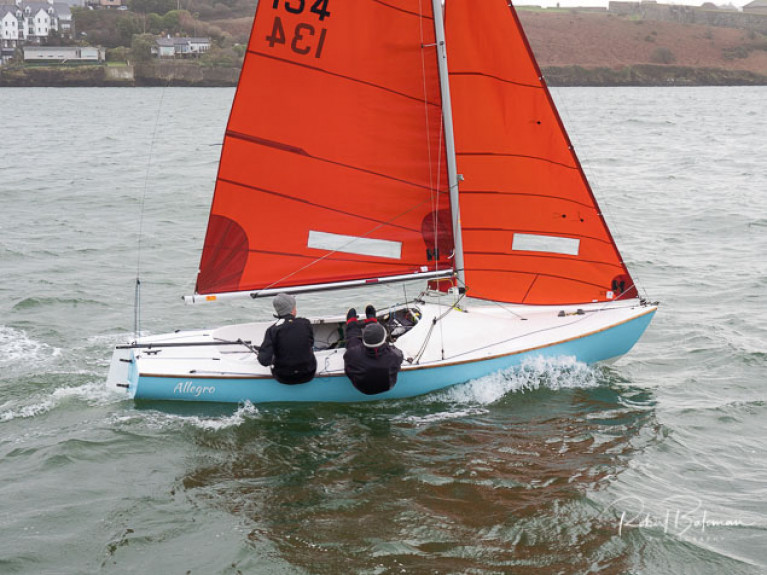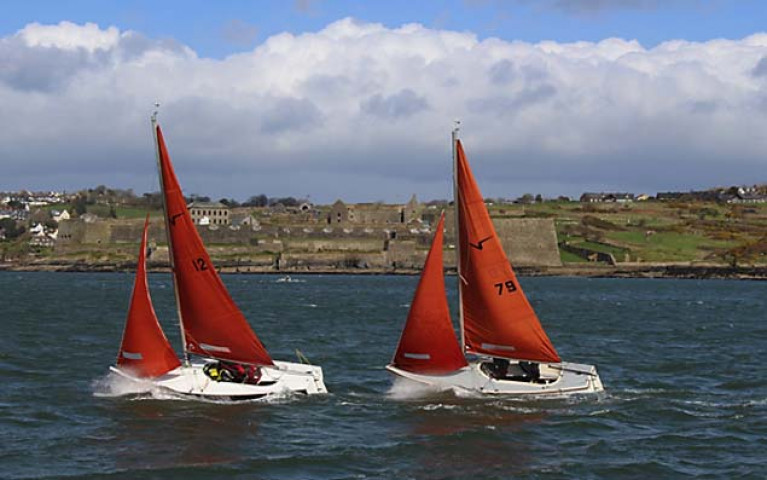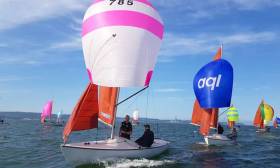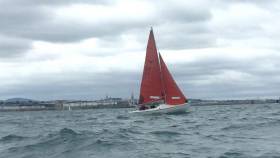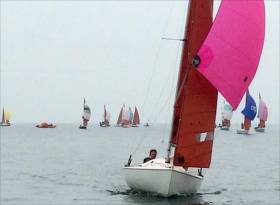Displaying items by tag: squib
The first major Class championships this season and the first in Cork Harbour will go ahead at Cove Sailing Club next weekend. The Squib Southerns will be based at the new Cove SC clubhouse and marina at Whitepoint.
The event and the marina are a big boost for the harbour town. Cobh has long-needed facilities for visiting boats. Several previous attempts to build a marina there failed. Cove Sailing Club, which celebrated its centenary last year, undertook its own project. It was not without difficulties and financial pressures which did create some internal club difficulties. At one stage another club, the Great Island Sailing Club, was formed and organised cruiser racing while remaining club members devoted their attention to getting the marina built. They succeeded, the new marina is now in operation, the clubs have re-united, with Great Island ceasing activities and members back in Cove Sailing Club which is a busy place at present.
 Race Officers get the first race away from Cove Island Sailing Club's new marina pontoons Photo: Bob Bateman
Race Officers get the first race away from Cove Island Sailing Club's new marina pontoons Photo: Bob Bateman
There is also a new clubhouse and dinghy sailing is resuming, with training courses also going ahead.
Kieran Dorgan is Cove Sailing Club’s Commodore and is my Podcast guest this week, discussing the developments and the economic boost which the marina will provide to the town of Cobh. I started by asking him about the Squibs Southern Championships next weekend, with racing on Saturday and Sunday, July 25 and 26:
Cove Sailing Club’S first evening league of the season was won by Commodore Dorgan’s Altair, a First 36.7 David Doyle’s Sigma 33, Musketeer, was second and Norman Allen’s Impala, Nadia, third. Twelve yachts raced.
What To Do When The Sailing Season Seems to Collapse?
One-by-one they came in this week – cancellations of planned events. The Royal Cork’s 300th celebrations. I commiserated with the club’s Admiral, Colin Morehead. A tough decision for him in his first few months in office. Cork Week had to be abandoned. The Squib National Championships at Kinsale which, when I wrote last week’s column were still going ahead, were also cancelled as were many other planned events.
One of my favourites, the Classics at Glandore Harbour Yacht Club in West Cork, which I’ve sailed in several times, are set for July 18-24 and were to connect with the RCYC’s 300th.
Commodore, Eamon Timoney has told club members that GHYC is still committed to the Classic 2020 schedule but, things may change: “Our strategy is to plan for our various events, including the Classic Regatta until such time as a cancellation or postponement is required. The Committee will endeavour to do this in a timely way.”
Another of the major events in which I take particular interest and raced three times - the Round Ireland Yacht Race - is still set for Saturday, June 20. Wicklow Sailing Club says it will “make a call on whether or not to go ahead with the race towards the end of April.”
This weekend, my own club the RCYC closed its entire site including access to the marinas until Easter Sunday, April 12.
So what to do when the planned sailing season seems to collapse? My plan had been for installing some new electronics on Scribbler, my Sigma 33. I was looking forward to that, all planned when the crisis hit. Now she sits amongst many other boats in the boatyard as the sailing fraternity waits to see what will happen.
Upwind & Downwind Sailing
So I’ve been turning my mind to thoughts of that beautiful moment at the start of each season when Scribbler lifts to the first wave after she’s been launched and wondering when I will feel that moment this year.
In this frame of mind, I’ve been considering upwind and downwind sailing.
When I took up the sport I was told that upwind is “toughest and worst” as the boat and crew beat a course to reach the windward mark. When the sea is bouncy it sure is not pleasant. As a novice learner I was told that the reward came with “freeing sails” and “setting the spinnaker.”
How then to account for my feeling of anxiety and concern that seems to encase my thoughts when that forward-bearing cloth goes up. I’ve sailed on various boats with different owners and listened to the shouts of “sheet; no get the guy; no I said sheet in; for pity’s sake let it out, it’s going to twist….” Those instructions are not always couched in pleasant terms and more brusque and blunt words have been used.
I’ve ”flown the spinnaker” on yachts of my own and on other people’s, on boats of various sizes; in the Round Ireland; across the Atlantic in the Whitbread Round the World Race. My family crew love “getting the spinnaker up,” with obvious delight and a feeling of fulfilment when it fills and Scribbler pulls away with the power of the crinkling upfront sail…
So, is my view of spinnakers because my early experiences of cruisers, contrasted from an owner whose view was “best left at home in the attic,” or the enthusiast for having his multi-coloured spinnaker flying when, as we cruised on a nice day off Schull, sun shining, the water nicely flat, happy with a sandwich and a glass of wine when he announced he wanted the spinnaker up and one of my crewmates replied: “Oh no, just when we were all getting along so nicely…..”
Listen to the PODCAST below
Kinsale Squib Nationals is Cancelled in June
The Squib National Championships 2020 scheduled for 21 - 26 June at Kinsale Yacht Club has been cancelled.
Regatta Director, Ruth Ennis told Afloat: 'The Squib 2020 Organising Committee in conjunction with Kinsale Yacht Club and the N.S.O.A. reluctantly made this decision in light of the COVID-19 pandemic'.
The prospect of the championships going ahead was discussed as recently as this week by Tom MacSweeney on Afloat here.
Ennis says Kinsale is looking at the 'possibility and logistics of hosting the event in Kinsale Yacht Club next year 2021'. All registration fees to the event will be refunded.
Kinsale Yacht Club Remains Committed to Squib Nationals
A “squib” I was told when first shown one of these boats by its owner, is “an explosive boat.
Several of them were riding nicely on the rippling water at Kinsale Marina that day two years ago when it was announced that Kinsale Yacht Club would be the location for a joint event bonding the Irish and Uk fleets in both their national championships together, then to be held in two years’ time.
“Explosive in performance, challenging and fast .. a great boat to sail,” I was told. That was back in 2018 and the Squib owner was making the point that they would be every bit as important to Kinsale as cruisers, “a major part of the club’s sailing fleet.”
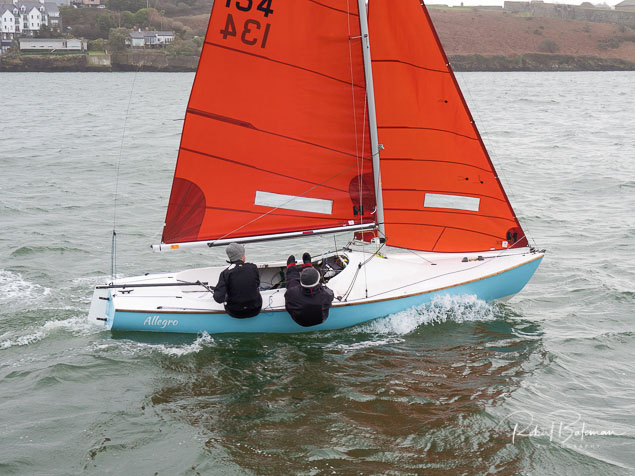 Above and Below: Local Squib duo Colm Dunne and Rob Gill sailing in Kinsale Harbour Photo: Bob Bateman
Above and Below: Local Squib duo Colm Dunne and Rob Gill sailing in Kinsale Harbour Photo: Bob Bateman
There are Squibs in the fleets of several clubs around the country and they come to my mind this week because they were the last big racing fleet on the water before the shut down of sailing. We are at the stage where there is neither physical contact with our boats in most cases, as well as social isolation in our sport and uncertainty about when it will be able to resume.

The Squib is a racing keelboat for a crew of two, designed in 1967 by Oliver Lee as a successor to the Ajax 23. It is a one-design class of 5.79 metres long and a beam of 1.87 metres. The Royal Yachting Association in the UK gave them national keelboat recognition. They have the advantage of being trailed pretty easily, according to their advocates.
One of the big tactical successes in promoting Squibs was made by the class In 1974 when, with sail numbers approaching 400, leading British yachting journalists were invited to Burnham-on-Crouch to race Squibs, in an event called the ‘Squib Symposium.
“This resulted in raising the Squib's profile with the yachting press,” says the Class. And there was an extra benefit from all that publicity! Around this time, the UK Design Council put the Squib on its index of selected designs. A pretty good recognition.
The original boat design by Oliver Lee for Hunter Boats has had changes made by the Class as interest evolved. The dinghy is credited for having led to the building of the Hunter 19, which was described as putting “a lid on the Squib.” The Squib also spawned the Sandhopper, a boat with shoal draught and triple keels of which 45 have been built and raced on the British East Coast.
The Squib National Championships and UK Championships are due to be held this Summer at Kinsale Yacht Club, scheduled for June 21-26. A lot of work has been put into the preparation of the event and now, of course, the Coronavirus Covid-19 crisis is causing a degree of concern.
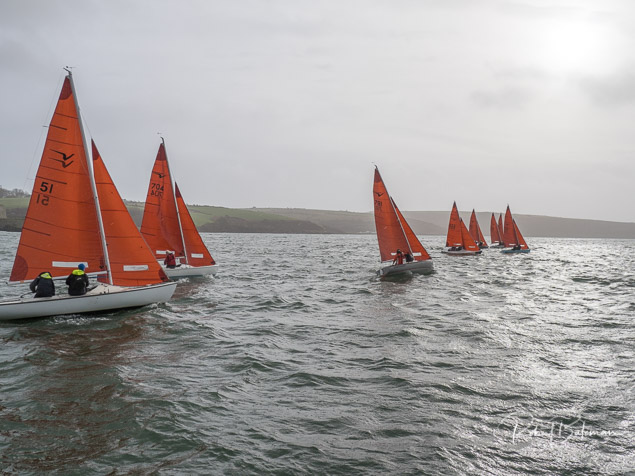 A recent Squib class start at Kinsale in February 2020 Photo: Bob Bateman
A recent Squib class start at Kinsale in February 2020 Photo: Bob Bateman
The Committee in Kinsale, led by Regatta Director Ruth Ennis, announced this weekend that it remains “committed to running the championships. We are aware that the situation regarding Covid-19 continues to evolve.” If the event must be postponed or cancelled a full refund will be available it says to those who have already entered. The club has an experienced organising team in place, building on the success of many previous large events hosted by KYC.
Custom Rigging Frostbite Series at Kinsale Yacht Club
For the record, that last competitive event before the sailing close-down was the final day of the Custom Rigging Frostbite series at Kinsale Yacht Club and it was a testing one for all competitors. Wind speeds gusted to 30 knots, averaging between 19 and 21 with gusts going from 27 to 30.
"There were eleven Squibs racing in the Series"
There were eleven Squibs racing in the Series, with sponsor Harry Lewis amongst them. Sailing with Sean O’Riordan in Longshot, the duo won third prize overall.
The series winner was Allegro raced by Colm Dunne and Rob Gill. They had seven first places and finished third across the line in two other races. Second was Outlaw, sailed by Ian Travers and Keith O’Riordan, who won two of the races in the series and had five second places. Allegro finished on 7 points, Outlaw had a total of 12 and Longshot 25 points.
The Squibs also raced under ECHO handicap, in which the final positions changed from the premier division. Under ECHO, Outlaw finished 1st, Allegro was 2nd and Sibu, sailed by Geraldine and Denis Kieran got third place.
And that explosive” comment about the performance of the boats, made by that Squib owner in Kinsale has an appropriate definition. The word “squib” is defined in dictionaries as “a small firework that burns with a hissing sound before exploding….”
Listen to the podcast below:
The 2020 UK Squib National Championships come to Ireland once every five years and this summer Kinsale Yacht Club is hosting the event.
The event takes place from 21st to 26th June in one of the most scenic parts of the country, which also happens to be the Gourmet Capital of Ireland and voted one of the top ten most colourful towns in Ireland.
The club has announced some incentives to competitors to enter the event early.
A series of draws will take place on the following dates.
- 29th February - draw for a Hyde cockpit cover
- 17th March - draw for six bottles of wine
- 1st April - win a bottle of champagne.
Results of each draw will be published and prizes may be collected from KYC Squib Class prior to or at registration. All entrants are eligible for each draw unless you are lucky enough to have won a prize.
Click here to enter.
Lough Derg Yacht Club Expects Record Entry from Squibs, Flying Fifteens & SB20s for Freshwater Championships
Lough Derg Yacht Club is hosting its annual keelboat regatta on the weekend of the 11th and 12th of October. The event will be a wrap up to the season for many of the competitors and over 50 entries are expected from three classes - making it one of the biggest sailing events of the year on the Shannon.
The big attraction for many sailors is the beautiful autumnal setting of Lough Derg but also the opportunity to thoroughly wash the boat out in freshwater at the end of the season.
The Squibs will be welcoming visitors from the UK as well as Belfast, Strangford Lough, Howth, Kinsale and Dun Laoghaire. As Afloat reported earlier, Kinsale Yacht Club will be promoting their UK and Irish Nationals which are being held in June 2020.
Irish Sailing President Jack Roy and his daughter Jill have indicated they will compete as will UK champion Dick Batt. Squib stalwart Vincent Delany, second in the recent Irish Nationals, is also sailing as is Irish Champions Gordon Patterson and Ross Nolan from Royal North.
The SB20s have just announced that the Irish Nationals will be hosted in Lough Ree in Sept 2020 and a good fleet is expected - including Lough Derg and Lough Ree entries.
The Flying Fifteen fleet, who have just completed a World Championship in Dun Laoghaire are also reported to be travelling to Dromineer in numbers, just a week after the class hosts the All Ireland Sailing Championships at the National Yacht Club. It may be the only winter sailing for the FF's at Dun Laoghaire Harbour given the current winter hard standing woes currently in place.
Unfortunately, the Dragons this year are not competing due to 90th birthday celebrations in Italy where nine Irish boats are competing.
Day 1 of the 50th Anniversary Squib Irish National Championships at Royal North of Ireland Yacht Club on Belfast Lough had all the hallmarks of champagne sailing, sun out, blue skies and a steady breeze but only for a few more knots to make it perfection. First round the windward mark was 601 Squiblet, sailed by Ian McMillan & Laura Fitzgerald, with Fagin and Inshallah and Outlaw close behind. Race one finished, Fagin 1st, Inshallah 2nd and Outlaw 3rd.
Race 2 took a little while to get under way after a brief postponement and general recall. The black flag was up and unfortunately, Fagin got caught out along with Lil Quickie and Born Wild. This time it was Outlaw, Prodigal, Firecracker and Femme Fatale, fighting it out at the front, Inshallah was showing great boat speed and managed to pull through the fleet to take 3rd from Femme. At the finish, it was Outlaw, Firecracker.
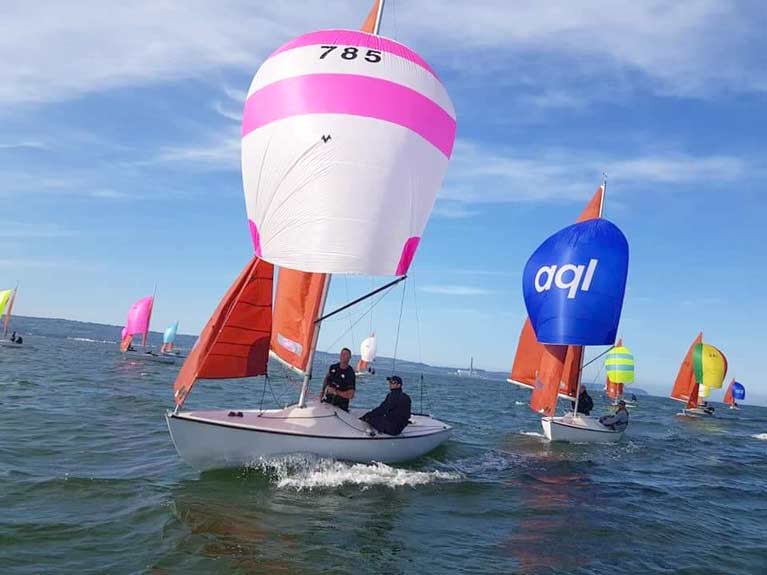
Race 3, The race started in a light and shifty SE breeze, the fleet were away clean and, in true Holywood style, the underdog came good; Vincent Delaney and Joe O'Byrne had the bit between their teeth and sailed away from the fleet, with Inshallah showed amazing boat speed to pull through the fleet into 2nd and Maximus holding onto 3rd.
Race 4 started in similar breeze and direction but getting even more shifty, Prodigal, sailed by father and son duo Greg and Harry Bell, led round the windward mark. Again, as in any fairytale, Femme Fatale showing speed had a blinder and took the win, with Fagin 2nd and Outlaw 3rd.
Race 5. After a short postponement and movement of the committee boats to go and find the breeze, the race got under way in marginal racing conditions, Maximus lead round the first mark to later find out they had been Black-flagged after a very taxing run in little the fleet went inside out. At the finish it was Fagin making the most of the light, shifty conditions taking the win and Worm having a great race, sailed by Sam Lyness and Eric Heyes and Volante, sailed by Simon Watson and Jordy Withers, had a brilliant race finishing 3rd.
It was a battle royale with Outlaw and Fagin fighting it out for the overall win.
Race 6, started in a SE 6/7 knot breeze that was building. The race got away clean and a tricky beat saw Maximus, sailed by Wallace and Weatherstone, round the windward mark first closely followed by Born Wild, Thomas and Jack Anderson and Prodigal, Greg and Harry Bell. Prodigal closed the gap down to Maxiums up the beat but Maximus managed to take the win, while this was going on Fagin and Outlaw were fighting for the Championship down in 6th and 10th place with Femme Fatale finishing 9th place.

Race 7, started in a stronger breeze 10/12 Knots from the SE. This time is was The Worm sailed by Sam Lyness and Eric Heyes that rounded the windward mark first, closely followed by Maximus and Outlaw and Femme Fatale. Maximus managed to get into the lead by the leeward gate but missed a shift up the last beat to allow The Worm back into the lead. Femme Fatale also clawed back into contention. The Worm took the win by the half a boat length, then Maximus and Femme Fatale. While this was going on, Fagin and Outlaw were still slugging it out in the fleet with Fagin finding the advantage and taking a 4th over outlaw in 6th.
This meant that Fagin sailed by Gordon Patterson and Ross Nolan took the 2019 50th Anniversary Irish Squib Nationals.
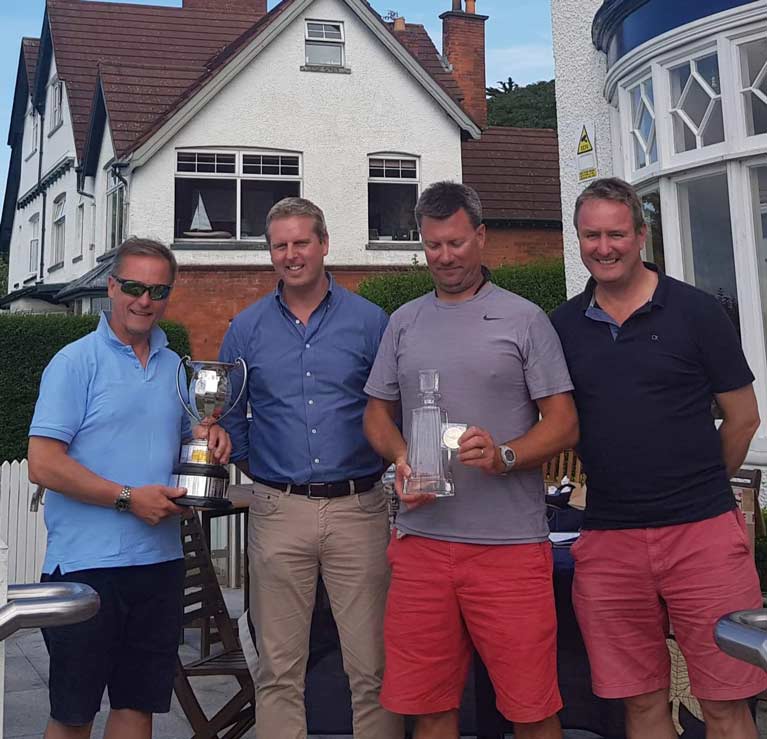
- 2nd Femme Fatale, Vincent Delaney and Joe O'Byrne with Noel also crewing.
- 3rd Outlaw, Ian Travers and Keith O'Riordan.
- 4th Maximus, Peter Wallace and Martin Weatherstone.
- 5th Inshallah, David Eccles and Phil Hutchinson



Article by Martin Weatherstone. Photos by Lindsay Nolan and Martin Weatherstone
The Volvo Dun Laoghaire Regatta takes place every two years, and each edition seems to grow both in status and in the number of boats competing. Between 11-14 July 500 boats competed in 34 classes. Did any of the classes stand out beyond the others?
The Black sails of Cruiser 1 Class were distinctive. The striped topsails of the Howth 17 foot one design encouraged the viewer to seek out an ice-cream stall. Some of the Seabird half-raters and Trearddur Bay Myths and the Classic Keelboats sported coloured sails, but the mace coloured sailed of the Squibs made them a distinctive entire fleet. On Thursday Squibs raced on the windward-leeward Centre course. In light winds, the recently acquired ‘Crackertoo’ sailed by Jeff Kay from Howth won by a good margin. Could he dominate the series to become the ‘Boat of the Regatta’?
On an overcast, Friday Squibs moved to the South Course which utilised the permanent Dublin Bay marks. ‘The Backstop’ sailed by Jill Fleming and Vincent Delany dominated the day with three first places in an 18-20 knot wind.
On a sunny Saturday with the light northerly winds on the windward-leeward North Course Rupert and Rory Westrup in ‘Sidewinder’ swopping helm and crewing positions as the race progressed won the first race, ‘The Backstop’ won race two, and ‘Sidewinder’ won race three to show her aspiration to win the series.
On Sunday there was a fading breeze, resulting in only one race being sailed on the ‘South Course’. This time ‘The Backstop’ held the lead from beginning to end to win the 8 race series with 9 points, compared with ‘Sidewinder’ on 12 points and ‘Crackertoo’ on 26 points.
Oh to be in Kinsale on a sunny Saturday with a breeze watching the wonderfully named Fagin, Outlaw, Slipstream, Allegro, Nimble and Kanaloa zipping around offshore marks battling like gladiators in Squibs for best positions at windward and leeward buoys, ducking and diving under the eagle eye of Race Officer Tony Small and his team aboard Destiny who got three races in… what a great first day reports Dave O'Sullivan.
The Championships was sponsored by Fusco Artisan, CH Marine and Mamuko.
Sunday turned out to be tougher for all with an overcast start followed by a sea mist later. Three races were once again sailed over a long day with boats finally alongside at 1600 with a crane awaiting to lift visitors ashore.
The nineteen boat fleet saw great competition with only four points separating first and fourth in the end after a discard.
Gold Fleet Results
Fagin (Royal NIYC – G. Patterson & R .Nolan) were overall winners by one point to Outlaw (Kinsale YC – I. Travers & K. O’Riordan) with Slipstream (Killyeagh YC – R. Marshall & B. Kelly) third, just ahead of Allegro (Kinsale YC – C. Dunne & F. Ward).
Silver Fleet Results
First place went to Sensation (Kinsale YC - B. & D. Cudmore) with Nebulette (Kinsale YC - M. Barry & L. Bond) second and Flora (Kinsale YC - B. Nash & D. Ross) third.
All agreed that it was a great test run for the Squib Nationals due to be held in Kinsale in late June 2020
Results here
Kinsale Yacht Club's Colm Dunne and Rob Gill are lying in third place overall in Torquay in Allegro in UK Squib Nationals after two races.
Dublin Bay's Jill Fleming and Vincent Delany finished 10th in race 2 in a fleet of 57 at the Royal Torbay hosted event.
Results are here




























